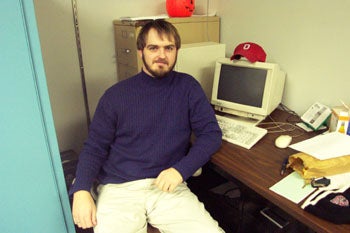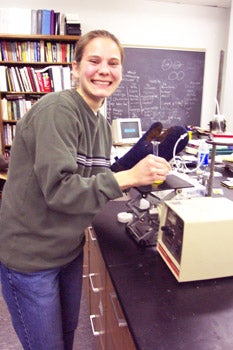Department of Chemical and Biomedical Engineering
Mailing Address
Chemical and Biomedical Engineering Department Washkewicz College of Engineering
Cleveland State University
2121 Euclid Ave., FH 455
Cleveland, Ohio 44115-2214
Campus Location
Fenn Hall Room 455
1960 East 24th Street
Phone: 216-687-2569
Fax: 216-686-9220
che@csuohio.edu
Contact
Stephanie McLeod, Secretary
Phone: 216-687-2571
s.l.mcleod@csuohio.edu
Current Research Assistants
Study of Catalytic Reactions as Mechanisms of High-Temperature Lubrication

Study of Catalytic Effects of Transition-Metals on Organic Precursors for Protective and Conversion Coatings on Solid Substrates
With the raise of environmental awareness, chromate-based coating processes have been elevated to the rank of the technologies targeted by the EPA for rapid replacement by environmentally firendly processes. Therefore, there is a clear need for new advances in coating technology to identify alternatives to present industrial practices.
My research examines the CSU-developed process as an alternative deposition technique to generate uniform coatings onto solid substrates. Experimental evidence, however, point to the chemical interaction between precursors and transition metals as an essential stage in determining the success or failure of the deposition process. This work aims at elucidating the effect of this interaction on reaction mechanisms leading to high-performance coatings, consisting of deposition experiments with spectroscopic and molecular studies.
- resume
- Contact Carolina: Sofalvi@aol.com
Java-based Interactive Computer Modules

Modeling and Numerical Simulation of Metabolic Pathways: A Simplified Compartmental Model for Brain Metabolism

A mathematical model of metabolic pathways in the human brain is developed. The model assumes a compartmental lumped model with 15 reactions and 15 metabolites. Transport between the blood flow and the astrocyte compartment, and the astrocyte and neuron compartments are considered.A robust numerical algorithm is implemented using the Livermore Solver for Ordinary Differential Equations (LSODE). The system of equations is reduced to a minimal set, with parameters estimated through a Levenberg-Marquardt non-linear regression algorithm, and based on measurements for dynamics responses in mammalian brains. Brain and local flow responses for fasting, exercise and hypoxia are studied. Preliminary comparison with experimental data is provided.
Committee members :
- Dr. Jorge E. Gatica
- Dr. Joanne M. Belovich
- Dr. George P. Chatzimavroudis
- resume
- Contact Carolina: dhanda_21@yahoo.com

Jeff recently joined our Group, his research description will be updated soon !
Generalized Approach to Include Thermodynamic Constraints in Metabolic Pathways

Complex metabolic pathways are comprised of many chemical species, reactions and biochemical fluxes. Due to the difficulty in physically obtaining reaction rate constants for individual biochemical reactions, flux balances are often employed to reduce the number of unknowns. Although flux balances can be useful predictive tools, their use without the inclusion of proper thermodynamic constraints can result in physically unrealizable conditions. However, by introducing energy balances through the inclusion of metabolite chemical potentials into the pathway analysis, a constrained optimization problem is obtained whose solution is limited by chemical equilibrium conditions. This formulation can, in turn, be used to more reliably estimate biochemical reaction rate parameters resulting in more robust mathematical models. This research is an attempt to generalize the application of this concept to arbitrary metabolic pathways. The application to parameter estimation and mechanism validation in brain metabolism will be used as an illustrative case study.
<!-- close copy -->
Mailing Address
Chemical and Biomedical Engineering Department Washkewicz College of Engineering
Cleveland State University
2121 Euclid Ave., FH 455
Cleveland, Ohio 44115-2214
Campus Location
Fenn Hall Room 455
1960 East 24th Street
Phone: 216-687-2569
Fax: 216-686-9220
che@csuohio.edu
Contact
Stephanie McLeod, Secretary
Phone: 216-687-2571
s.l.mcleod@csuohio.edu